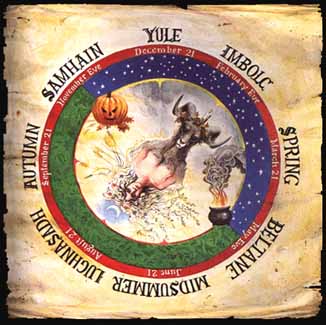
The Wheel of the Year is the Wiccan calendar. Unlike many other religions, Wicca sees time as cyclic, not linear. We therefore use a wheel, or circle to represent our year. The Wheel of the Year is broken down into eight parts because it is a solar based calendar. The esbats - new and full moons - are not represented on the calendar, but are celebrated. The esbats are celebrated in circle with invocation, spell work; especially on the full moon, and class work such as meditation, story telling or trance work. Sabbats are celebrated with seasonal food, myths of the holiday and other traditional activities.
Sabbats
Yule, Winter Solstice, Dec. 21 or 22 usually.
The solstices and equinoxes depend upon the sun's position and can move one or two days in any given year.
Legend: Yule is the rebirth of the sun, when the days grow longer. It is the rebirth of the Oak King in the Oak King/Holly King myth. The young Oak King, who represents summer, slays the aging Holly King, who represents winter. Also symbolic of this myth in England boys go out and slay a wren, the bird of winter and the Holly King, and take the dead bird around the village singing. Mummer's Plays are performed that enact the death of the Oak King at the hand of the Holly King.
Practice: Yule trees are decorated and wassail is made. Wassail is ale, brandy and hard cider spiced with cinnamon, ginger, nutmeg and cloved apples. Wassail is then taken around to the neighbor's homes while caroling. Presents are exchanged. Yule logs burned.
Imbolc, Feb. 2
One of the cross-quarters, or those holidays between the equinoxes and solstices. Because these holidays are Celtic in origin, their celebrations start at sundown the night before and run through the next day. Thus, Samhain starts at sundown on Oct. 31 and runs through Nov.1.
Legend: This holiday is also called Brigitsmas or Candlemas. All the old wax is melted down to make new candles. In Ireland a small bed is made of reeds or rushes and left in a corner for Brigit. Divination is traditional on this day. Cattle are driven between two bonfires for health and fertility.
Practice: During rituals so many candles are lit that it is bright as day. Divination is done using a touchstone. This is a blue stone kept in the hearth of the home for the prior year and then put in a shallow glass bowl filled with water for scrying. (scrying is a type of divination)
Oestara, Mar. 22 (spring equinox)
Legend: Little is changed from this Pagan holiday to its Christian counterpart, Easter, even the name is similar.Rabbits, long a symbol of fertility are abundant at this time, heralding the onset of spring.
Practice: Color eggs brightly and toss into running water. This action is supposed to awaken the spirits in the Underworld to return and begin life anew.
Beltaine, May 1
Legend: Traditionally this was not a fixed holiday, it was Beltaine whenever the first white flowers appeared on the trees. Young girls wash their faces in the morning dew to preserve youthfulness. Maypoles are danced by the young men of the village. Morris and Garland dancing happen, Morris by the young men in the fields, Garland by the young girls on the town square.
Practice: Maypole dancing is still common and Morris/Garland Dancing is also popular in some parts of the country. Women and girls still wash their faces in the morning dew to insure continued youthful complexions.
Litha, June 19
Legend: The crops are in the ground, not yet ready to be harvested.Sheep shearing is begun in some areas, so this is still a working sabbat. Herb harvest begins at this time for most herbs. Traditional time of marriages.
Practice: Still a good time for marriages, symbolic and real. Celebrate the union of the God and Goddess, that which created all life.
Lughnasadh, Aug. 1
Legend: Feast of the God Lugh, a time for contests, foot races and other sporting events. There is little work to be done at this time, so there is lots of time for play and fun.
Practice: Games and contests of all sorts since Lugh was skilled at all crafts from weaving to blacksmithing.
Mabon, Sept. 22
Legend: Beginning of the harvest, the first sheaves of grain are in and the first loaves from those sheaves are returned to the fields in thanks.
Practice: Take food to area charities, leave a loaf of baked bread as an offering in a field. Some type of sacrifice at this season is also important, whether a lock of hair or a piece of jewelry. It shows that you understand that everything you have is a gift from the Gods.
Samhain, Nov. 1
Legend: The time of the Wild Ride or Wild Hunt, when the Faerie folk ride in this world. The veil between our world and the underworld is thin at this time and it is easy to cross-over. Returning, however, is not easy and caution is required in outings on this night. In some parts of England and Ireland parents will not let their children out on this night.
Practice: Remembering those who have died in the last year and setting a place for them at dinner is common. This is also the Celtic New Year, so New Year's resolutions are appropriate as is divination to see what the upcoming year holds for you.
These are very brief summaries of some practices and legends surrounding the sabbats. The practices and the accompanying lore will vary from tradition to tradition, depending upon the Gods a groups works with.